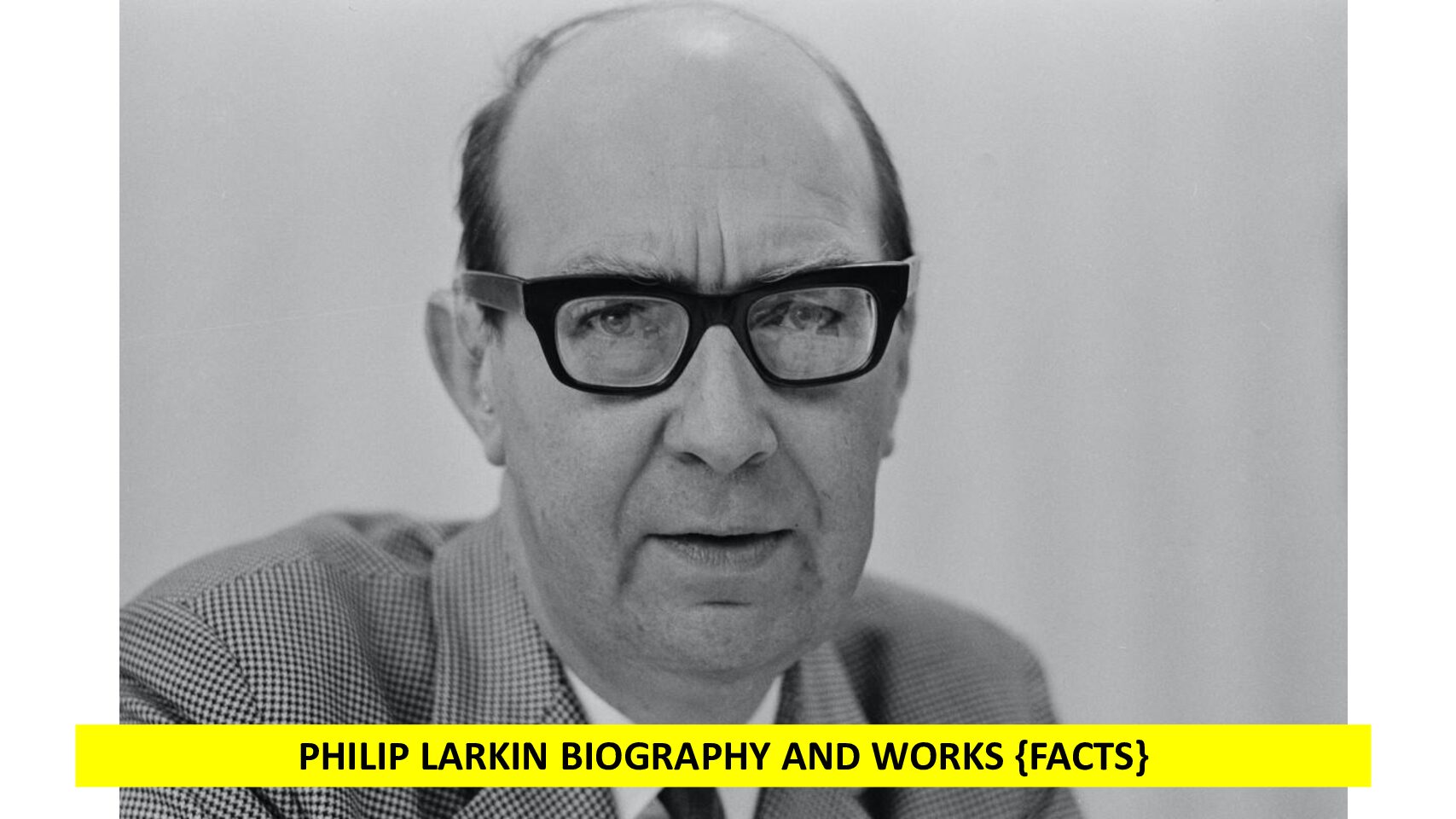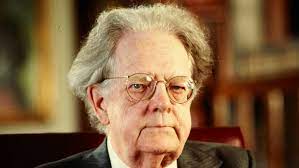Philip Larkin Biography and Works , Philip Arthur Larkin, born on August 9, 1922, in Coventry, England, is widely regarded as one of the preeminent poets and writers of the 20th century. His literary corpus is distinguished by a unique voice, astute observations, and a profound exploration of the human experience. Larkin’s life and contributions are intricately entwined with the post-war British literary landscape, reflecting the societal changes and cultural shifts of his era.
Raised in Coventry, an industrial city that profoundly influenced his perspective on modernity and urban life, Larkin hailed from a modest middle-class family. The economic hardships of the Great Depression, experienced during his formative years, left an enduring impact on his later writings. His father, Sydney Larkin, served as the city treasurer, while his mother, Eva Emily Day, fostered his early love for literature. Larkin’s academic excellence became evident during his tenure at King Henry VIII School in Coventry, where he excelled in English and displayed a budding passion for poetry.
Continuing his journey at St. John’s College, Oxford, Larkin pursued studies in English language and literature. Oxford provided a fertile ground for intellectual exploration and literary pursuits. Interactions with fellow literary figures, including Kingsley Amis, left an indelible mark on Larkin, shaping his literary sensibilities and fostering enduring friendships. However, his time at Oxford was interrupted by World War II, during which he served in the Royal Air Force from 1943 to 1945. The war’s profound impact influenced the thematic currents of his later works.
Post-war, Larkin resumed his studies at Oxford and eventually embarked on a career in librarianship. In 1950, he assumed the role of librarian at the University of Hull, a position he held until his demise. The academic environment at Hull provided stability and a conducive space for creative expression. Larkin’s role as a librarian underscored his commitment to facilitating access to literature, reflecting his belief in the transformative power of words.
Larkin’s poetic debut occurred with “The North Ship” in 1945, a collection reflecting the influence of W.B. Yeats on his early style. However, it was “The Less Deceived” (1955), his second collection, that thrust him into the literary limelight. The title encapsulates Larkin’s nuanced exploration of disillusionment, a theme pervasive in his work. Well-received for its clarity of language and acute observations, the collection established Larkin as a prominent voice in post-war poetry.
In subsequent years, Larkin produced notable poetry collections, including “The Whitsun Weddings” (1964) and “High Windows” (1974). These works delve into the complexities of love, mortality, and the passage of time, illustrating Larkin’s preoccupation with the human condition. His poems, marked by a blend of wit and melancholy, capture everyday life with a keen eye for detail. Larkin’s accessible and rhythmic poetic language resonated with a broad readership, solidifying his reputation as a poet for the people.
Beyond poetry, Larkin made significant contributions to prose. His critical essays and reviews, compiled in volumes such as “All What Jazz: A Record Diary” (1970) and “Required Writing” (1983), showcase his incisive literary analysis and wit. Larkin’s prose writings offer insights into his views on literature, culture, and the role of the artist in society.
Larkin’s personal life, often shielded from public scrutiny, adds complexity to his public persona. His romantic relationships, notably with Monica Jones and Maeve Brennan, colleagues at the Hull University library, have been subjects of speculation. Themes of love, loneliness, and human connection in his poetry intersect with the intricacies of his personal life.
Larkin’s impact extends beyond his individual works. As the librarian at the University of Hull, he played a pivotal role in fostering a literary community, supporting emerging writers like Kingsley Amis and Barbara Pym. The Philip Larkin Prize, established in his honor, celebrates outstanding young poets and underscores his enduring legacy as a mentor and advocate for literature.
However, Larkin’s legacy is not without controversy. Revelations about his private correspondence and personal beliefs in the latter part of his life sparked debates about his political views and attitudes towards race and gender. Scrutiny of his letters revealed elements of conservatism and skepticism towards societal changes, prompting a reevaluation of his work in contemporary discussions on inclusivity and social justice.
In conclusion, Philip Larkin stands as a towering figure in 20th-century literature, leaving an indelible mark with his poetry and prose. His exploration of the human experience, coupled with a keen sense of observation and mastery of language, resonates across generations. Larkin’s life journey, from the industrial landscapes of Coventry to the academic haven of Hull, shaped his worldview and informed his literary creations. Despite the complexities of his legacy, the enduring power of Larkin’s words ensures his significance in the canon of English literature.
Philip Larkin Famous Poems
Philip Larkin, renowned for his poignant and often reflective poetry, left an enduring legacy with several famous and widely studied poems that continue to resonate with readers. Here, we explore some of his most notable works:
- “Church Going” (1955): In “Church Going,” Larkin reflects on the role of religion in contemporary society. The poem begins with the speaker entering a deserted church, contemplating its significance and pondering the future of such religious institutions. Larkin explores themes of spirituality, tradition, and the enduring human need for a sense of sacred space.
- “This Be The Verse” (1971): Arguably one of Larkin’s most famous and controversial poems, “This Be The Verse” opens with the memorable lines, “They fuck you up, your mum and dad.” The poem delves into the idea of how familial and societal influences shape individuals and impact their lives. Larkin’s candid and irreverent language captures the complexities of family relationships.
- “The Whitsun Weddings” (1964): The title poem of one of Larkin’s collections, “The Whitsun Weddings,” narrates a train journey on a Whitsun weekend, observing wedding parties at various stops. Through vivid imagery and keen observations, Larkin explores the themes of love, marriage, and the transient nature of human connections. The poem is celebrated for its evocative depiction of a pivotal moment in time.
- “Toads” (1955): “Toads” is a two-part poem where Larkin contrasts the lives of those who choose routine and security (representing the metaphorical “toad”) with those who pursue their passions and dreams. The poem reflects Larkin’s skepticism towards the monotony of conventional life and the compromises people make in the pursuit of comfort.
- “An Arundel Tomb” (1964): In this contemplative poem, Larkin reflects on the permanence of love and memory. The poem is inspired by the tomb of Richard Fitzalan and his wife Eleanor in Arundel Cathedral. Larkin explores the idea that even in death, the physical presence of a monument can convey a sense of enduring love and connection.
- “MCMXIV” (1964): Written in the context of World War I, “MCMXIV” (1914 in Roman numerals) captures the atmosphere of pre-war England, depicting a world on the brink of change. Larkin reflects on the innocence of a generation before the war’s profound impact, emphasizing the loss of an idyllic past and the inevitability of societal transformation.
-
“Aubade” (1977): “Aubade” is a meditation on mortality and the fear of death. Larkin explores the existential dread that often accompanies the awareness of our own finite existence. The poem is a stark and introspective piece that delves into the darkness of the human psyche, contemplating the void that death represents.
What was Philip Larkin’s writing style?
-
Accessible Language: Larkin’s poetry is known for its accessibility. He eschews complex, ornate language in favor of a more straightforward and conversational style. This accessibility allows a broad readership to engage with his work, contributing to his popularity.
- Everyday Subjects: Larkin often draws inspiration from mundane, everyday experiences. His poems frequently explore ordinary moments and situations, transforming them into profound reflections on life, love, and mortality. This choice of subject matter contributes to the relatability of his poetry.
- Wit and Irony: Larkin’s writing is characterized by a sharp wit and a penchant for irony. He often employs humor to underscore deeper, sometimes darker, truths about the human condition. This combination of wit and irony adds layers of complexity to his verses.
- Observational Precision: Larkin’s poems are marked by meticulous observation and attention to detail. He captures scenes with vivid imagery and precision, allowing readers to visualize and connect with the landscapes, people, and moments he describes. This observational skill enhances the authenticity of his work.
- Exploration of Human Experience: Larkin’s poetry delves into the complexities of the human experience. He explores themes such as love, loneliness, disillusionment, and the passage of time with a profound and often contemplative lens. His keen understanding of the human psyche contributes to the emotional resonance of his poems.
- Free Verse and Traditional Forms: While Larkin is associated with free verse, he also employs traditional poetic forms. His versatility is evident in his use of rhyme and meter when the structure serves the thematic elements of a particular poem. This willingness to adapt his form to the needs of each poem showcases his mastery of craft.
- Pessimism and Realism: Larkin’s writing often exhibits a sense of pessimism and realism. He confronts the harsh realities of life, acknowledging the inevitability of death, the transience of joy, and the disappointments inherent in human relationships. This candid exploration of darker themes distinguishes his work.
-
Conciseness: Larkin’s poems are often concise, yet they carry immense depth. He has a knack for distilling complex emotions and ideas into succinct verses, making each word count. This economy of language contributes to the impact of his poetry.

















